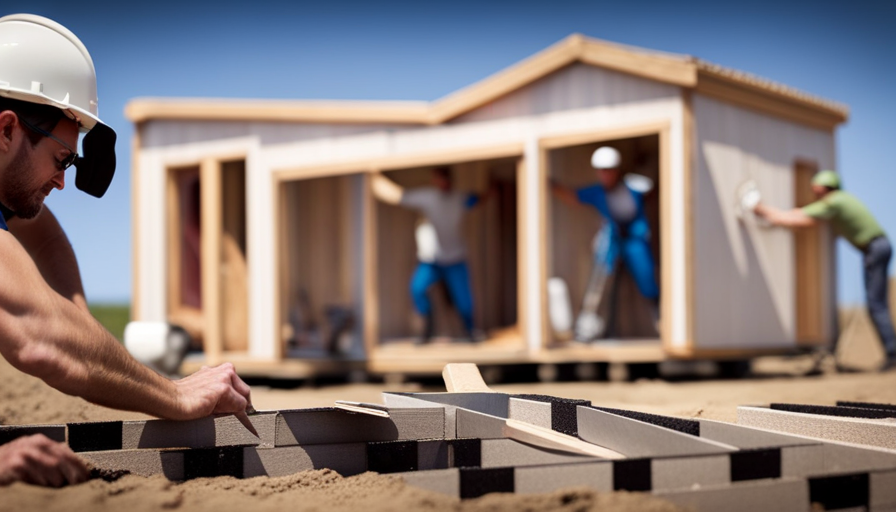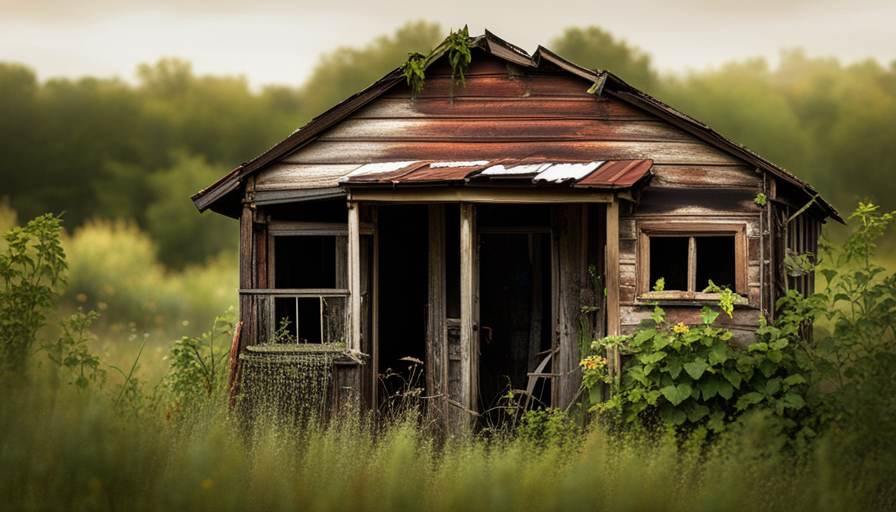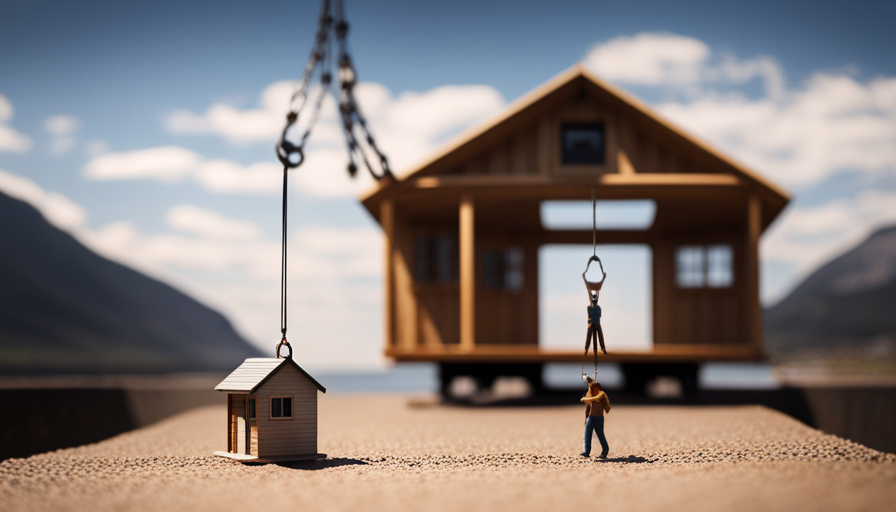Have you ever dreamed about building a cozy retreat of your own – a small house where you can escape from the pressures of modern life? But before you start this exciting project, there’s an important question you need to consider: when do you need to get a building permit?
Building regulations can be a complex maze to navigate, but understanding the requirements is crucial to ensure your tiny house is safe, legal, and meets all necessary standards.
In this article, I will guide you through the process of determining when you need a building permit for your tiny house, from the initial planning and design phase to the final inspections and certifications. We will also explore the resources and support available to help you navigate the world of tiny house construction and live in your dream home legally.
So, let’s embark on this journey together and discover the steps to building your very own tiny house while staying within the bounds of the law.
Key Takeaways
- Building regulations and permits are important for ensuring the safety and legality of a tiny house.
- Building permits are usually required once the tiny house exceeds a certain size or height.
- Local zoning and land use regulations dictate where and how you can build your tiny house.
- The planning and design phase is crucial and sets the foundation for the entire project, including compliance with building codes and local regulations.
Understanding Building Regulations for Tiny Houses
So, you’re ready to start building your dream tiny house, but do you know at what point you’ll need to secure a building permit?
Understanding building regulations for tiny houses is crucial to ensure you comply with all the necessary requirements. Building code requirements vary depending on your location, so it’s essential to research and familiarize yourself with the specific regulations in your area.
Building code requirements typically cover aspects such as structural integrity, electrical systems, plumbing, and fire safety. These regulations are in place to ensure that your tiny house meets certain standards and is safe for occupancy.
It’s important to note that building codes are not the same as zoning regulations, which dictate where you can place your tiny house.
When it comes to legal considerations, building permits are usually required once your tiny house exceeds a certain size or height. The specific criteria for when a building permit is needed can vary, so it’s crucial to consult with your local building department to determine the exact requirements for your project.
Understanding building code requirements and securing the necessary building permits are vital steps in the construction process. They not only ensure that your tiny house is safe and compliant but also prevent potential fines and legal issues.
Now let’s delve into the importance of building permits and how they can benefit your tiny house project.
The Importance of Building Permits
Before embarking on your petite abode project, remember that procuring proper permits plays a pivotal role in preserving the progress and preventing potential problems. Building permits are essential for ensuring building code compliance and avoiding legal implications. These permits are issued by local government authorities and serve as official approval for the construction of your tiny house. They verify that your project meets the necessary safety and structural requirements outlined in the building codes.
Obtaining a building permit is not just a bureaucratic formality; it’s a crucial step in the construction process. Building without a permit can result in fines, penalties, and even legal action. Additionally, if you decide to sell your tiny house in the future, potential buyers may be hesitant to purchase a property that wasn’t built with the proper permits. Building permits are also important for insurance purposes. Without them, your insurer may refuse to cover any damages or liability claims that occur.
In the next section, we’ll delve into determining the size and type of tiny house, which is another important aspect to consider in your project.
Determining the Size and Type of Tiny House
When determining the size and type of a tiny house, it’s important to differentiate between mobile and permanent structures. Mobile tiny houses are built on trailers and can be moved from one location to another, while permanent structures are built on a foundation.
Additionally, it’s crucial to consider local zoning and land use regulations, as they may dictate where and how you can build your tiny house. It’s essential to be knowledgeable about these factors in order to ensure that your tiny house meets all legal requirements and can be enjoyed for years to come.
Differentiating between Mobile and Permanent Structures
As you’re envisioning your tiny house, picture the distinction between a mobile structure that can be moved and a permanent structure that becomes a part of the landscape. Understanding this difference is crucial when considering the legal considerations for tiny house owners. Here are a few key points to help you differentiate between temporary and permanent structures:
-
Mobility: A mobile tiny house is built on a trailer and can be transported to different locations, while a permanent tiny house is fixed on a foundation.
-
Size and Design: Mobile structures usually have size limitations and specific design requirements for road safety, whereas permanent structures can have more flexibility.
-
Building Codes: Mobile structures may have different building codes and regulations compared to permanent structures, so it’s important to research and comply with the appropriate codes.
-
Utility Connections: Permanent structures require utility connections such as water, electricity, and sewage, whereas mobile structures can be self-sufficient.
Considering these factors will help you determine whether you need a building permit for your specific type of tiny house. Moving forward, it’s essential to also consider local zoning and land use regulations.
Considering Local Zoning and Land Use Regulations
To truly navigate the legal considerations of owning a tiny house, it is crucial for you to carefully consider and understand the local zoning and land use regulations in your specific area. These regulations dictate where and how you can build your tiny house, and failing to comply with them can lead to serious consequences. To help you understand the impact of local zoning and land use regulations, consider the following table:
| Land Use Restrictions | Building Code Compliance |
|---|---|
| Residential Only | Must meet safety standards |
| Minimum Lot Size | Proper electrical and plumbing |
| Setback Requirements | Adequate insulation and ventilation |
| Height Restrictions | Structural integrity |
| Accessory Dwelling Units | Fire safety measures |
By familiarizing yourself with these regulations, you can ensure that your tiny house is legally compliant and avoid any potential issues. Understanding local zoning and land use regulations is just the first step in the planning and design phase of building a tiny house.
Planning and Design Phase
During the planning and design phase of building your tiny house, you’ll need to consider various factors and ensure that your vision aligns with local building codes and regulations. This phase is crucial as it sets the foundation for the entire project.
Here are three key considerations to keep in mind:
-
Building permit requirements: Research and understand the specific building permit requirements in your area. Each jurisdiction may have different regulations regarding the size, height, and location of tiny houses. Obtaining the necessary permits will ensure that your project is legal and safe.
-
Architectural considerations: Think about the overall design and layout of your tiny house. Consider factors such as energy efficiency, space optimization, and structural integrity. You may need to work with an architect or designer to ensure that your plans meet the necessary standards and regulations.
-
Material selection: Choosing the right materials is essential for the durability and safety of your tiny house. Consider using sustainable and eco-friendly materials that meet the required building codes. Research local suppliers and consult with professionals to ensure that your material choices will be approved during the permit process.
As you finalize your plans and move into the foundation and site preparation phase, it’s important to ensure that all necessary permits are obtained and that your design aligns with local regulations.
Foundation and Site Preparation
First things first, before you can start building your dream tiny house, make sure you lay a solid foundation and properly prepare the site. This is an essential step in the construction process and requires careful attention to building permits and site regulations.
Building permits are typically required for any construction project, including tiny houses. They ensure that your project complies with local building codes and regulations. It’s important to check with your local authorities to determine the specific requirements for obtaining a building permit for your tiny house.
Additionally, site regulations may dictate where your tiny house can be placed on your property and what type of foundation is allowed. Some areas may require a concrete slab foundation, while others may allow for alternative options such as pier and beam or a trailer.
Properly preparing the site involves clearing the land, leveling the ground, and addressing any drainage or utility considerations. Once you have obtained the necessary building permits and prepared the site, you can move on to the exciting construction phase.
Construction Phase
Once you’ve laid the groundwork and taken care of the necessary paperwork, it’s time to roll up your sleeves and start bringing your vision to life. The construction phase of building a tiny house is where all your hard work and planning start to pay off. However, before you dive headfirst into the construction process, it’s crucial to understand the permit requirements and navigate the application process smoothly.
To help you get started, here are three key points to keep in mind:
-
Research local building codes: Each jurisdiction has its own set of regulations for constructing a tiny house. It’s essential to familiarize yourself with these codes to ensure compliance throughout the construction process.
-
Consult with professionals: If you’re not confident in your construction skills, it’s wise to consult with professionals such as architects or contractors who specialize in tiny house construction. They can guide you through the process, ensuring your project meets all necessary requirements.
-
Submitting the application: Once you have a clear understanding of the permit requirements, it’s time to submit your application. Make sure you have all the necessary documents and information ready to avoid any delays or complications.
As you wrap up the construction phase and move on to the next step of interior finishing and amenities, remember that attention to detail and precision are key to creating a comfortable and functional tiny home.
Interior Finishing and Amenities
To truly transform your tiny home into a cozy and inviting space, it’s all about the interior finishing touches and the amenities that make it uniquely yours. When it comes to interior design in a tiny house, every inch matters. You have to carefully plan the layout to ensure that every nook and cranny is utilized efficiently.
From choosing the right color scheme to selecting furniture that maximizes space, it’s important to create a cohesive and functional design.
Once the layout is finalized, it’s time to focus on the plumbing and electrical installation. This is a crucial step in making your tiny house livable and comfortable. You need to ensure that the plumbing system is properly installed, including the water supply, drainage, and sewage. Additionally, the electrical system should be designed and installed to meet the specific needs of your tiny house, including outlets, lighting fixtures, and appliances.
After the interior design, plumbing, and electrical installation are completed, it’s time to move on to the final inspections and certifications. These inspections ensure that your tiny house meets all safety and building code requirements. It’s important to have these certifications in order to legally occupy your tiny house and ensure the safety of yourself and others.
Final Inspections and Certifications
When it comes to final inspections and certifications for a tiny house, there are three key points to consider.
First, it’s important to schedule inspections with the appropriate authorities at different stages of construction to ensure compliance with building codes and regulations.
Second, any violations or issues that are identified during these inspections must be promptly addressed and resolved.
Finally, once all inspections have been successfully completed and any violations have been rectified, the tiny house owner can receive the necessary certificates of occupancy to legally occupy and use the dwelling.
Scheduling Inspections
Don’t forget to schedule inspections for your tiny house construction project or risk facing a mountain of legal troubles! Scheduling inspections and obtaining permits are crucial steps in the process of building a tiny house.
Inspections ensure that your construction meets the required safety and building codes. To schedule inspections, you’ll need to contact your local building department and provide them with the necessary information, such as the type of inspection needed and the proposed date and time.
It’s important to be proactive and schedule inspections well in advance, as there may be a waiting period. Once the inspections are scheduled, make sure to be present during the inspections and have all the required documents and permits available for review.
Addressing any violations or issues that arise during the inspections is vital to ensure that your tiny house construction remains in compliance with the regulations.
Addressing Any Violations or Issues
Dealing with any violations or issues that come up during inspections is crucial to keeping your tiny house construction project on track. Addressing violations promptly and effectively is essential to ensure that your tiny house meets all necessary building codes and regulations.
If any violations are identified during the inspection process, it’s important to take immediate action to resolve them. This may involve making necessary modifications or repairs to bring your tiny house into compliance. It’s important to work closely with the building inspector to understand the specific requirements and guidelines that need to be followed.
By addressing violations and resolving any issues in a timely manner, you can ensure that your tiny house construction project progresses smoothly. This will help you move closer to receiving the necessary certificates of occupancy for your completed tiny house construction project.
Receiving Certificates of Occupancy
Now that any violations or issues with the construction of the tiny house have been addressed, the next step is to obtain the necessary certificates of occupancy. These certificates are official documents that indicate the tiny house meets all the building code requirements and is safe to be occupied. In order to receive these certificates, the building permits must be renewed periodically. This involves submitting documentation to the local building department, such as updated plans and inspections, to ensure continued compliance with the building code. Navigating the building code requirements can be a complex process, but it is crucial for ensuring the safety and legality of the tiny house. Once the certificates of occupancy are obtained, you can move forward with living in your tiny house legally and enjoy the benefits of this unique lifestyle.
Living in a Tiny House Legally
When it comes to living in a Tiny House legally, it’s crucial to understand the local regulations for occupancy. Each area may have different rules and requirements, so it’s important to research and comply with these regulations to avoid any legal complications.
Additionally, dealing with zoning and parking restrictions can be challenging, but it’s necessary to find suitable locations that allow tiny house living.
Lastly, joining tiny house communities or associations can provide valuable resources and support for navigating the legal aspects of living in a tiny house, as well as connecting with like-minded individuals who share similar interests and experiences.
Understanding Local Regulations for Occupancy
Before you dive into the world of tiny house construction, it’s important to unravel the intricate maze of local regulations governing occupancy, just like a skilled detective unravels a complex web of clues to solve a mysterious case.
Understanding the occupancy requirements and permit application process is crucial to ensuring that your tiny house is legally occupied. Each jurisdiction may have different rules, so it’s essential to research and familiarize yourself with the specific regulations in your area.
Some areas may require you to obtain a building permit before you can occupy your tiny house, while others may have specific size restrictions or zoning requirements. By understanding these regulations, you can navigate through the process smoothly and ensure that you are in compliance with the law.
Now, let’s delve into the next section and explore how to deal with zoning and parking restrictions.
Dealing with Zoning and Parking Restrictions
To successfully navigate through zoning and parking restrictions, it’s crucial that you familiarize yourself with the specific regulations in your area. Here are three key points to consider when dealing with parking restrictions and navigating through zoning regulations:
-
Understand the parking requirements: Different areas have different rules regarding where you can park your tiny house. Some may require a designated parking space, while others may allow you to park on your own property. Make sure you know the requirements before starting your build.
-
Research zoning regulations: Zoning regulations dictate what type of structures are allowed in certain areas. It’s important to check if tiny houses are permitted in the location you have in mind. You may need to apply for a special permit or variance to comply with the regulations.
-
Consult with local authorities: If you’re unsure about the specific regulations in your area, reach out to the local zoning department or planning commission. They can provide guidance and answer any questions you may have.
By understanding these regulations, you can ensure that your tiny house project complies with the necessary rules and restrictions. This knowledge will also help you transition into the subsequent section about joining tiny house communities or associations.
Joining Tiny House Communities or Associations
Immerse yourself in the vibrant tapestry of community and belonging by joining a network of like-minded individuals in tiny house communities or associations, where the seeds of friendship and inspiration flourish.
Joining tiny house communities is a fantastic way to connect with others who share your passion for simple living and sustainable housing. These communities often provide a platform for exchanging ideas, sharing resources, and supporting each other throughout the building process.
Additionally, being part of a tiny house community can help you find affordable land, as members often share information about available plots or even purchase land collectively to create a community. By joining these communities, you not only gain a supportive network, but you also increase your chances of finding suitable land for your tiny house.
Transitioning into the subsequent section, let’s explore the various resources and support available for tiny house builders.
Resources and Support for Tiny House Builders
Don’t miss out on the valuable resources and support available to you as a tiny house builder! Building a tiny house can be a challenging endeavor, but with the right resources and support, you can make your dream a reality. When it comes to financing and finding land for your tiny house, there are several helpful options available.
One of the first steps in building a tiny house is securing financing. There are various resources for financing a tiny house, including personal savings, loans, and grants. Personal savings can be a great option if you have been saving money specifically for your tiny house project. Additionally, there are lenders who specialize in tiny house financing and can provide loans tailored to your needs. Some organizations even offer grants to support individuals building sustainable and affordable housing.
Finding land for your tiny house is another crucial aspect of the building process. There are online platforms and websites that can help you find available land for sale or rent. Additionally, joining tiny house communities or associations can provide you with valuable connections and resources for finding land. These communities often have access to land that is specifically designated for tiny houses, making your search much easier.
As a tiny house builder, there are numerous resources and support networks available to assist you with financing and finding land for your project. By utilizing these resources, you can navigate the building process with confidence and bring your tiny house dreams to life.
| Resources for Financing | Finding Land | |||
|---|---|---|---|---|
| Personal savings | Online platforms | |||
| Loans | Tiny house communities | |||
| Grants | Joining associations | Mortgage options | Renting land | |
| Crowdfunding | Land sharing agreements | |||
| RV loans | Lease-to-own options | |||
| Home equity loans | Land auctions | |||
| Peer-to-peer lending | Land brokers | |||
| Family and friends loans | Landowner financing | |||
| Government assistance programs | Land lease agreements | |||
| Small business loans | Land trusts | |||
| Personal fundraisers | Bartering for land | |||
| Sponsorships | Homesteading programs | |||
| Community loans | Landowner partnerships | |||
| Microloans | Land crowdfunding | |||
| Credit cards | Land swap agreements |
These are just some of the resources available for financing and finding land for your tiny house. It’s important to research and explore multiple options to find the best fit for your individual circumstances and goals.
Frequently Asked Questions
Are there any exemptions or exceptions to obtaining a building permit for a tiny house?
Oh, exemptions and exceptions to building permits for tiny houses? Absolutely none! It’s so refreshing how the system treats all types of homes equally. No need to worry about navigating any loopholes or special considerations.
What are the potential consequences of building a tiny house without a permit?
Building a tiny house without a permit can lead to potential consequences such as fines, legal action, and having to halt or dismantle the construction. It’s important to obtain the necessary permits to avoid these issues.
How long does it typically take to obtain a building permit for a tiny house?
Obtaining a building permit for a tiny house can take anywhere from a few weeks to several months. The average processing time depends on the specific location and the complexity of the project. Common challenges include meeting zoning requirements and obtaining necessary documentation.
Are there any specific regulations or requirements for off-grid tiny houses?
Off-grid tiny houses have specific regulations and requirements to promote sustainable construction and off-grid living. These may include using renewable energy sources, managing waste properly, and ensuring self-sufficiency in water and power supply.
Can I build a tiny house in a residential neighborhood or do I need to find a specific location for it?
I can build a tiny house in a residential neighborhood, but I need to find a suitable location for it. There may be zoning restrictions or homeowner association rules to consider before starting construction.
Conclusion
Well, folks, after diving into the world of building permits for tiny houses, it’s clear that navigating the regulations can be quite the adventure. Who knew that the size and type of your tiny abode could determine whether or not you need a permit?
And let’s not forget the joy of final inspections and certifications. But fear not, fellow tiny house enthusiasts, there are resources and support out there to help you live legally in your compact dream home. Happy permitting, everyone!
Hi, I’m Emma. I’m the Editor in Chief of Tiny House 43, a blog all about tiny houses. While tree houses are often associated with childhood, they can be the perfect adult retreat. They offer a cozy space to relax and unwind, surrounded by nature. And since they’re typically built on stilts or raised platforms, they offer stunning views that traditional homes simply can’t match. If you’re looking for a unique and romantic getaway, a tree house tiny house might just be the perfect option.










